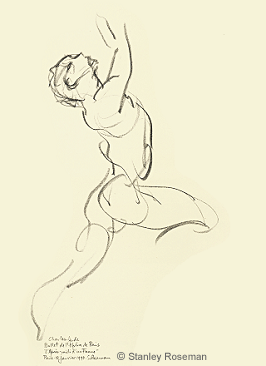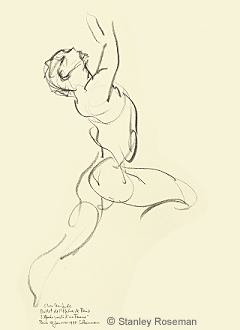
© Stanley Roseman and Ronald Davis - All Rights Reserved
Visual imagery and website content may not be reproduced in any form whatsoever.
Visual imagery and website content may not be reproduced in any form whatsoever.

Stanley Roseman Drawings
Charles Jude, 1990
Paris Opéra Ballet
L'Après-midi d'un Faune
Pencil on paper, 37.5 x 27.5 cm
Bibliothèque Nationale de France, Paris
Paris Opéra Ballet
L'Après-midi d'un Faune
Pencil on paper, 37.5 x 27.5 cm
Bibliothèque Nationale de France, Paris
BALLETS RUSSES
L'Aprés-midi d'un Faune
The Ballets Russes' famous production L'Après-midi d'un Faune has been revived with great success by the Paris Opéra Ballet and is included in the Company's standard repertory.
''At the outset of my work at the Paris Opéra, in January 1990,'' recounts Roseman, "I had the wonderful opportunity to draw star dancer Charles Jude in L'Après-midi d'un Faune. Charles Jude interpreted the role of the Faun in 1976, the year the ballet entered the repertory of the Paris Opéra Ballet, and is acclaimed for his performances of the sensual Faun, as well as for other memorable balletic personages, including Petrouchka from the repertory of the Ballets Russes.''
In a text to accompany his drawings at the Paris Opéra, Roseman writes: "The idea for a ballet about the amorous yearnings of a faun on a summer afternoon derives from Stéphane Mallarmé's Symbolist poem L'Après-midi d'un Faune, published in Paris in 1876.
"Serge Diaghilev, the impresario of the Ballets Russes, entrusted the choreography of L'Après-midi d'un Faune to Vaslav Nijinsky, his first venture as a choreographer. Nijinsky worked in collaboration with Leon Bakst, who designed the sets and costumes.
"Claude Debussy was inspired by Mallarme's poem and composed Prélude à l'Après-midi d'un Faune, which premiered in Paris in 1894 at the Société Nationale de Musique. The Prélude has become one of the most celebrated works of modern music.
"Nijinsky developed his choreographic tableau to the impressionist imagery evoked by Debussy's music. The dancers' stylized, angular movements are seen mostly in profile and are reminiscent of figures on Greek (Attic) vases from the fifth to fourth centuries B.C.[1] The Ballets Russes presented the world premiere of L'Après-midi d'un Faune, conducted by Pierre Monteux, at the Théâtre du Châtelet in Paris in 1912."


3. Charles Jude, 1990
Paris Opéra Ballet
L'Après-midi d'un Faune
Pencil on paper, 37.5 x 27.5 cm
Bibliothèque Nationale de France, Paris
Paris Opéra Ballet
L'Après-midi d'un Faune
Pencil on paper, 37.5 x 27.5 cm
Bibliothèque Nationale de France, Paris
This page will present further work by the artist from L'Après-midi d'un Faune.
Please return again.
Please return again.
"Doris Monteux wrote a loving memoir of her husband and quotes the Maestro's early admiration for Debussy's music: 'I was young, and I found his music subtle and intriguing. I fell in love with all of it…'[2]
2. Claude Debussy, Prélude à l'Après-midi d'un Faune.
Flute solo of the opening bars of Debussy's score.
Flute solo of the opening bars of Debussy's score.
On a summer afternoon, a faun, perched on a hillock, watches a gathering of seven nymphs. The Faun approaches, and they soon flee, save for one nymph who has disrobed to her undergarments to bathe in a stream. Lingering, she entices the Faun and intertwines her arms with his in a suggestive dance movement. The nymph then also departs, leaving her diaphanous scarf on the ground. The Faun retrieves the scarf and inhales its female scent. Carrying his trophy, the Faun, taking deliberate steps, ascends to his perch, smoothes out the material, and gently lowers himself onto the nymph's scarf. With a sudden bodily thrust upward, the Faun reaches a climax. As Debussy's music subsides, the Faun reposes and the curtain falls.


The Bibliothèque Nationale de France conserves Roseman's superb drawing Charles Jude, 1990, presented at the top of the page and below, (fig. 3). Drawn from the perspective of the audience, the Paris Opéra star dancer as the Faun is seen in profile in keeping with the choreographic style of L'Après-midi d'un Faune.
Roseman has beautifully expressed the sensuality of the male dancer and the personage of the amorous Faun, skillfully portrayed by Charles Jude in this classic work of modern dance.
"Stanley Roseman's drawings show the many facets of his great talents as a draughtsman.''[4]
- Bibliothèque Nationale de France
"The music of Debussy was familiar to me from my own youth when I heard the Prélude à L'Après-midi d'un Faune at a marvelous concert conducted by Pierre Monteux at the Tanglewood Music Festival in the Berkshires in western Massachusetts. Staying with my parents in the same hotel as the eminent French-born conductor and Madame Monteux, I had the wonderful experience of becoming friends with the respected couple. As well as painting and drawing, I was studying piano at the time. The Maestro and Madame Monteux greatly encouraged me in my interests in music and art.''[3]
The erotic imagery of Roseman's drawing is emphasized by the vertical composition which places the male figure in the center of the page, with torso arched, arms raised, face turned upward, and mouth open. The taut stomach is drawn with a dark, calligraphic stroke of the pencil; strong lines define the strain of the dancer's back and his muscular buttocks, thighs and calves. His right leg is raised and bent at the knee as his outstretched left leg propels him forward.
1. Jean-Michel Nectoux, L'Après-midi d'un Faune, Mallarmé, Debussy, Nijinsky, (Paris: Les Dossiers du Musée D'Orsay, 1989), p. 18.
2. Doris Monteux, It's All in the Music, (New York: Farrar, Straus & Giroux, 1965), p. 46.
3. On the friendship of Monteux and Roseman, see further the previous website page "Stanley Roseman and the Ballet Russes: Petrouchka.''
In his youth, Roseman made a drawing of the octogenarian Maestro. Granting the young artist's request to autograph his drawing,
Monteux included with his signature a personal dedication: "To Stanley, with my best friendship.''
4. Stanley Roseman - Dessins sur la Danse à l'Opéra de Paris - Drawings on the Dance at the Paris Opéra, (text in French and English),
(Paris: Bibliothèque Nationale de France, 1996), p. 12.
2. Doris Monteux, It's All in the Music, (New York: Farrar, Straus & Giroux, 1965), p. 46.
3. On the friendship of Monteux and Roseman, see further the previous website page "Stanley Roseman and the Ballet Russes: Petrouchka.''
In his youth, Roseman made a drawing of the octogenarian Maestro. Granting the young artist's request to autograph his drawing,
Monteux included with his signature a personal dedication: "To Stanley, with my best friendship.''
4. Stanley Roseman - Dessins sur la Danse à l'Opéra de Paris - Drawings on the Dance at the Paris Opéra, (text in French and English),
(Paris: Bibliothèque Nationale de France, 1996), p. 12.
Page 1 - Petrouchka
Page 2 - L'Après-midi d'un Faune
Page 3 - The Rite of Spring
Page 2 - L'Après-midi d'un Faune
Page 3 - The Rite of Spring
BALLETS RUSSES